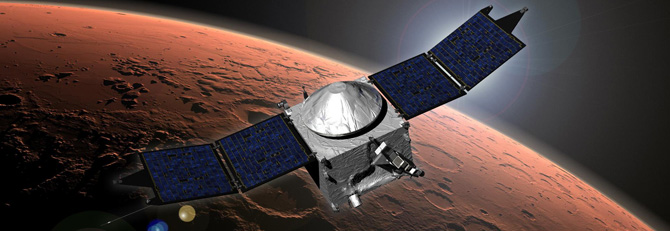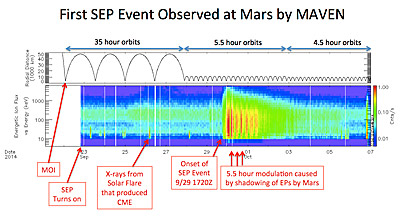MAVEN spacecraft begins exploration of climate change on Mars

NASA’s MAVEN spacecraft settled into its planned orbit around Mars on Sept. 21 and is already sending back data about the upper atmosphere, according to University of California, Berkeley, space scientist Davin Larson.
Larson, who led the development of the spacecraft’s Solar Energetic Particles instrument, participated in a NASA media teleconference yesterday (Tuesday, Oct. 14) to share what the MAVEN spacecraft has seen in its first few weeks at Mars.

“The main message is that it’s working,” said Larson, who is a researcher at UC Berkeley’s Space Sciences Laboratory. “We’ve already detected energetic particles from the sun.”
The SEP instrument detected its first incoming burst of energetic particles on Sept. 29, caused by a solar flare and coronal mass ejection from the sun three days earlier.
MAVEN, or the Mars Atmosphere and Volatile Evolution, rocketed into space in November 2013 and spent 10 months looping through the solar system before its arrival and orbit insertion around Mars. Its mission: to explore the upper part of the atmosphere and discover why Mars lost most of its atmosphere, including hydrogen and oxygen, billions of years ago. It is the first spacecraft devoted to exploring and understanding the Martian upper atmosphere to help scientists understand climate change over the Red Planet’s history.
Atmosphere stripped
Theory predicts there are many mechanisms that result in atmospheric loss, Larson said. One mechanism is that solar energetic particles, primarily protons or hydrogen ions originating from the sun, are partly responsible for stripping away the atmosphere.
“Solar energetic particles strike the upper atmosphere of Mars, ionizing the atoms and leading almost immediately to their escape from Mars,” Larson said.
The SEP instrument will measure the flux or intensity of solar energetic particles, while another instrument aboard MAVEN will measure the corona of escaped hydrogen and oxygen atoms around Mars, expecting to see the corona increase after an intense rain of energetic particles.
Models suggest that “the sun was much, much more active in the past with stronger and more frequent SEP events,” Larson said during the media briefing. “By understanding how the atmosphere is affected by SEPs today, we can calculate what role SEPs played in the evolution of Mars atmosphere.”
What they learn also could help space scientists understand why some planets, like Earth and Venus, still have thick atmospheres, while others, like Mars and Mercury, do not.
Other participants in the briefing were Elsayed Talaat, MAVEN program scientist at NASA Headquarters in Washington, D.C.; Bruce Jakosky, MAVEN principal investigator at the Laboratory for Atmospheric and Space Physics at the University of Colorado, Boulder; Mike Chaffin, Remote Sensing Team member at CU-Boulder; and Justin Deighan, CU-Boulder Remote Sensing Team member.
RELATED INFORMATION
- NASA Mission Provides Its First Look at Martian Upper Atmosphere (10/14/14 NASA press release)
- MAVEN spacecraft’s first look at Mars holds surprises (10/14/14 CU-Boulder press release)
- Berkeley space scientists say ‘bon voyage’ to Mars-bound MAVEN (11/18/13 press release)
- NASA mission asks why Mars has no atmosphere (10/7/10 press release)
